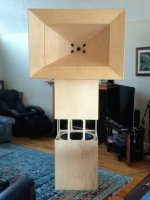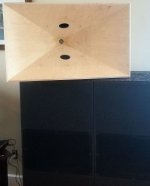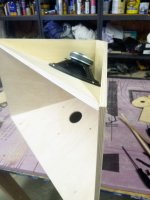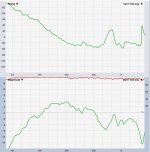Or at least I'm calling it Take 7.
It's really the 3rd completely different cabinet.
Other 'takes' were trying out different size ports or different drivers, etc.
They've all been desinged to go with subs at 100Hz like my previous synergy thread 100Hz two-way synergy project.
That thread ended up turning into this 60x40

I've truly enjoyed this speaker, to the point I wanted to build another for stereo, but it's too damn big and heavy to move around. About 100 lbs.
One of the biggest joys in audio for me, is being able to move gear around, listen outside, swap stuff around, always making comparisons and learning.
So I've spent a few months researching how to get the synergy goodness, but shed alot of weight.
Anyway here's the outcome.

It's a 90x60, that has very close to the same primary horn width and height, but of course less depth due to its wider pattern.
It weighs in at a glorious 45 lbs !!!
Uses two dirt cheap faital 10FE200's as mids, and one not so cheap b&c dcx 464 coax cd, ...but getting the CD down to 500Hz is what lets it work.
I did a few things different from my previous attempts that all tried to adhere to the conventional synergy wisdom.
Biggest change was putting the mid ports in the center of the horn instead of in the corners.
I made a test horn where I could block ports easily and experimented a bit. I couldn't find a compelling case for corner ports, in terms of how the HF and VHF were effected.
That was a peasant surprise really, because I wanted the ports in the horn center as part of a weight reduction design. It allowed the mid drivers to go on the top and bottom in small cavities, and the horn side walls be all the cabinent there is.
Like this

Plus, ports in the center of the horn are just plain easier to make
Also made a simple box to test port sizes and shapes, port thickness, and how much port frustrum matters. Picture a sealed box where you just lay a plate with various port tries on top, and move it around over the cone.
I used plates out of 12mm BB and thin steel sheet, and ended up choosing a 10:1 compression ratio in terms of hole size.
Surprisingly, I could not find anything to beat a simple round hole aligned with the center of the cone.
Neither could i find a reason to use thin ports, or even do anything to the wood hole other than a little roundover smoothing.
The port holes' center is 7.5" from the throat. Basically, the 10" drivers sit as close to the horn apex as possible, which also puts the port nearly under the center of the cone.
I always have to give sincere thanks to BWaslo for his speadsheet....I simply could not make a synergy without it.
Also need to thank Makita for my track saw Lol. It makes the bevel/miter cuts so easy and true...much better than i can do by table saw and sleds.
Oh, I've found I like to make the horn start at 1.4" square, and not have to round out the walls to mate the CD. It's been easier to add museum wax to the horn corners in the mouth.
Syn7 may or may not get a secondary flare depending on outdoor testing.
I should be able to make a detachable flare like in the first pic fairly easily.
What I really want to do is add a tractrix flare as the secondary flare.
Ala the K-402. I figure the K-402 first 2/3's from the throat is pretty much straight sided conical, and the last 1/3 tractrix. A conatrix or a tractical, depending on which end you look from haha
It's really the 3rd completely different cabinet.
Other 'takes' were trying out different size ports or different drivers, etc.
They've all been desinged to go with subs at 100Hz like my previous synergy thread 100Hz two-way synergy project.
That thread ended up turning into this 60x40

I've truly enjoyed this speaker, to the point I wanted to build another for stereo, but it's too damn big and heavy to move around. About 100 lbs.
One of the biggest joys in audio for me, is being able to move gear around, listen outside, swap stuff around, always making comparisons and learning.
So I've spent a few months researching how to get the synergy goodness, but shed alot of weight.
Anyway here's the outcome.

It's a 90x60, that has very close to the same primary horn width and height, but of course less depth due to its wider pattern.
It weighs in at a glorious 45 lbs !!!
Uses two dirt cheap faital 10FE200's as mids, and one not so cheap b&c dcx 464 coax cd, ...but getting the CD down to 500Hz is what lets it work.
I did a few things different from my previous attempts that all tried to adhere to the conventional synergy wisdom.
Biggest change was putting the mid ports in the center of the horn instead of in the corners.
I made a test horn where I could block ports easily and experimented a bit. I couldn't find a compelling case for corner ports, in terms of how the HF and VHF were effected.
That was a peasant surprise really, because I wanted the ports in the horn center as part of a weight reduction design. It allowed the mid drivers to go on the top and bottom in small cavities, and the horn side walls be all the cabinent there is.
Like this

Plus, ports in the center of the horn are just plain easier to make
Also made a simple box to test port sizes and shapes, port thickness, and how much port frustrum matters. Picture a sealed box where you just lay a plate with various port tries on top, and move it around over the cone.
I used plates out of 12mm BB and thin steel sheet, and ended up choosing a 10:1 compression ratio in terms of hole size.
Surprisingly, I could not find anything to beat a simple round hole aligned with the center of the cone.
Neither could i find a reason to use thin ports, or even do anything to the wood hole other than a little roundover smoothing.
The port holes' center is 7.5" from the throat. Basically, the 10" drivers sit as close to the horn apex as possible, which also puts the port nearly under the center of the cone.
I always have to give sincere thanks to BWaslo for his speadsheet....I simply could not make a synergy without it.
Also need to thank Makita for my track saw Lol. It makes the bevel/miter cuts so easy and true...much better than i can do by table saw and sleds.
Oh, I've found I like to make the horn start at 1.4" square, and not have to round out the walls to mate the CD. It's been easier to add museum wax to the horn corners in the mouth.
Syn7 may or may not get a secondary flare depending on outdoor testing.
I should be able to make a detachable flare like in the first pic fairly easily.
What I really want to do is add a tractrix flare as the secondary flare.
Ala the K-402. I figure the K-402 first 2/3's from the throat is pretty much straight sided conical, and the last 1/3 tractrix. A conatrix or a tractical, depending on which end you look from haha
Last edited by a moderator:
Cool horn!
Perhaps the problem with center ports occurs off axis?
Thx kipman725,
Great you asked that...because that was the test i used to evaluate the different port placement sizes, shapes, thicknesses, frustrum, etc.
The test being, how consistent was on-axis with off-axis.
If on-ax and off-ax vary consistently, response is totally fixable ime.
I'm confused why convention says put the ports in the corners .......
my measurements say why?
On-ax vs off-ax for Hf and VHf were about the same, corner vs middle...so why corners????
What seemed to matter the most for Mid, but definitely after port distance from throat, was getting the mid port under the middle of the mid driver.
All i know is i'm hearing truly glorious, and loud, sound from a 45lb speaker
Very cool! Is it easy to get (tune?) the throat area right with this design principle? Main thing preventing me to try one has been how to make the throat. Makita track saw surely is accurate! Very good tool for speaker builder.
Thx Tmuikku,
Yep, the Makita rocks ! It's crazy how much better my wood working has increased because of it.
I'm still digesting your super program....I'll try to tune this 'syn 7 'with it when i get proficient.
Hiding the ports in the corners and making them smaller had effects on the tweeters output, in that that when the ports are closer for midrange drivers the effects are greater. When you move them out further they have less effect. Pushing the tweeter lower like with your DCX makes a lot of the other compromises less important.I'm confused why convention says put the ports in the corners .......
my measurements say why?
On-ax vs off-ax for Hf and VHf were about the same, corner vs middle...so why corners????
What seemed to matter the most for Mid, but definitely after port distance from throat, was getting the mid port under the middle of the mid driver.
The depth, frustrumming and needing to use a cone plug comes down to trying to push the midrange low pass frequency higher. Horn resp sims shows the interaction of the volume of air in the throat chamber, port length and size. When you move the target down to 500Hz that is easier too. The 10FE200 also has a pretty shallow cone and not that much trapped air, a deeper cone might well present differently.
Centering the port over the driver will minimize path length differences and seems like a no brainer but it is not always possible when trying to juggle the physical size of midranges close enough to the throat.
Last edited:
Thx kipman725,
Great you asked that...because that was the test i used to evaluate the different port placement sizes, shapes, thicknesses, frustrum, etc.
The test being, how consistent was on-axis with off-axis.
If on-ax and off-ax vary consistently, response is totally fixable ime.
I'm confused why convention says put the ports in the corners .......
my measurements say why?
On-ax vs off-ax for Hf and VHf were about the same, corner vs middle...so why corners????
What seemed to matter the most for Mid, but definitely after port distance from throat, was getting the mid port under the middle of the mid driver.
All i know is i'm hearing truly glorious, and loud, sound from a 45lb speaker
The closer that you get to the throat, the more that the shape needs to be perfect.
IE, if you have some discontinuities in a horn and they're located three inches from the throat, it probably won't screw things up too much.
But as you get closer and closer, the shape of the horn becomes more and more critical.
Augerpro has some great examples of this in his 3D printed waveguide thread. He's got graphs that demonstrate that a change of just 2-4mm make a difference at the throat.
And the really depressing thing, is that if the throat is off, there's almost nothing you can do to fix it.
So, that's part of the reason why you want to 'hide' the midrange taps in a Unity horn. Particularly if the mids are close to the throat.
Mark100, I didn't do as thorough testing as you did, but in what I did test I also never saw much benefit from putting the taps in the corners -- the closer I got to the corners, the more issues I seemed to have. And getting the tap in the center of the midrange/midwoofer driver does wonders for the high end of the midrange driver if you can get it there. Skootching the upper corner of the midrange was always the battle in the syns I did. Getting that tweeter crossover point down lower is probably the best (though expensive) way to go. I'll be interested to see what people can do with that new Eminence compression driver.
Why not 3D print the throat part, and mount it as a component to the wood part? That would make the critical small dimensions consistent and easier to realize.
http://libinst.com/SynergyDIY/StubV6/V6 stub with airvolume plugs.stl
Hiding the ports in the corners and making them smaller had effects on the tweeters output, in that that when the ports are closer for midrange drivers the effects are greater. When you move them out further they have less effect. Pushing the tweeter lower like with your DCX makes a lot of the other compromises less important.
The depth, frustrumming and needing to use a cone plug comes down to trying to push the midrange low pass frequency higher. Horn resp sims shows the interaction of the volume of air in the throat chamber, port length and size. When you move the target down to 500Hz that is easier too. The 10FE200 also has a pretty shallow cone and not that much trapped air, a deeper cone might well present differently.
Centering the port over the driver will minimize path length differences and seems like a no brainer but it is not always possible when trying to juggle the physical size of midranges close enough to the throat.
Yep, what you and Patrick are saying about closer to throat having more potential negative impact, has been my understanding too.
If I were using a smaller 4-5" mid to bridge higher, I'd be very curious to try their ports out of the corners too....just to know...
The 10FE200 has been pleasant surprise, in how well it fit the design goal of low weight, and then how well the port size /location kinda fell into place.
I might end up reducing volume under the cone to try to raise response above 500Hz a bit more. But maybe not, it's sounding awfully good as is
Below is the mid raw response.

Oh, one test I just ran indoors, was a 1m sensitivity test on the processed mids, as the 10FE200's are clearly what will run out of steam first. (xovers at 100 and 500Hz)
The two 4 ohm drivers in series, give 102.5dB at 2.83V.
That calculates to about 127dB at AES wattage rating.
Not bad for a 45 lb box
Mark be happy camper !
Mark100, I didn't do as thorough testing as you did, but in what I did test I also never saw much benefit from putting the taps in the corners -- the closer I got to the corners, the more issues I seemed to have. And getting the tap in the center of the midrange/midwoofer driver does wonders for the high end of the midrange driver if you can get it there. Skootching the upper corner of the midrange was always the battle in the syns I did. Getting that tweeter crossover point down lower is probably the best (though expensive) way to go. I'll be interested to see what people can do with that new Eminence compression driver.
I thought I had remembered you saying ports out of the corners had worked for you. Thanks for replying with your experiences.
And yep, getting the port under the center on the cone, moved freq response up enough I haven't felt the need to reduce volume under the cone.
I'm very interested to see how the new Eminence works, too.
If CDs become better priced and can reach down into the dcx and bms low corner freq range, it seems like we will see a lot more builds skipping the smaller bridging mids.
your pix
Well, that's exactly what I had imagined!
Nice work Mark100! I also had a similar experience with making the crossover at 600Hz. I used a Heil AMT which let me go low. The mid range was easy to mount on the top panel. I used two hot dog shaped slots but probably a round would have worked too. The low XO is key to a an easy to make and simple Synergy. Basically following the FAST recipe for a low frequency crossover 2-way.
Nice work Mark100! I also had a similar experience with making the crossover at 600Hz. I used a Heil AMT which let me go low. The mid range was easy to mount on the top panel. I used two hot dog shaped slots but probably a round would have worked too. The low XO is key to a an easy to make and simple Synergy. Basically following the FAST recipe for a low frequency crossover 2-way.
Thx xrk971 !
Interesting you played with hotdog shapes too ... i wanted to try such, but ran out of experimenting willpower/patience lol..
So the Heil is good to 600Hz? That's really cool and very enticing...
Is that the reflection (from the throat/CD) null at around 630 Hz? Maybe you could kill it with mid impulse response inversion. It would be an interesting experiment...
I think probably so.
Mid inverse would be very interesting.
If i decide i need to push mid-to-high xover freq above 500Hz, I'll give this a try.
- Status
- This old topic is closed. If you want to reopen this topic, contact a moderator using the "Report Post" button.
- Home
- Loudspeakers
- Multi-Way
- synergy.....Take #7